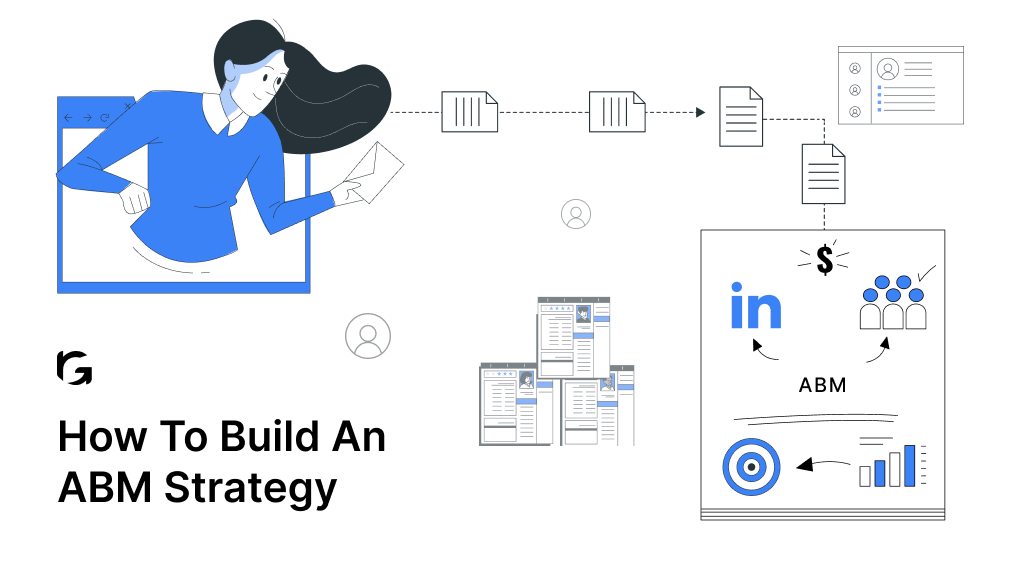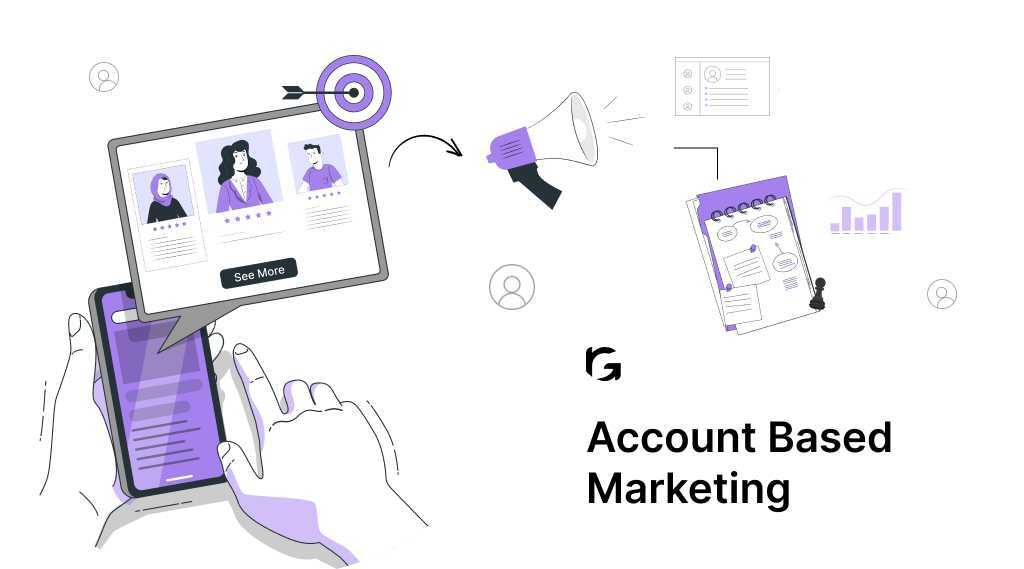In the ever-evolving landscape of B2B marketing, two distinct approaches have emerged as powerful strategies to drive growth and revenue: Account-Based Marketing (ABM) vs Traditional Marketing. As businesses strive to connect with their target audience and maximize their marketing efforts, understanding the differences between these two methodologies becomes crucial.
In this comprehensive comparison guide, we delve into the intricacies of ABM and Traditional Marketing, exploring their unique characteristics, benefits, and how they align with the needs of B2B marketers.
Whether you’re seeking to refine your existing marketing strategies or looking to make a significant shift, this guide will equip you with the knowledge and insights necessary to make informed decisions.
ABM vs traditional marketing : Understanding the basics
To navigate the ever-evolving B2B marketing landscape effectively, it is essential to grasp the fundamental differences between Account-Based Marketing (ABM) and Traditional Marketing. These two distinct approaches form the cornerstone of modern marketing strategies, each with its own unique characteristics and methodologies.
In this section, we delve into the basics of ABM and Traditional Marketing, unraveling their types and shedding light on their contrasting strategies.
What is account-based marketing (ABM)?
Account-Based Marketing (ABM) is a strategic approach that focuses on targeting specific high-value accounts with personalized marketing efforts. ABM aims to align sales and marketing efforts to engage and convert key accounts.
There are four main types of ABM:
- One-to-One ABM
- This approach involves creating highly customized marketing campaigns and experiences tailored to individual accounts.
- It requires significant personalization and typically suits organizations with a small number of high-value accounts.
2. One-to-Few ABM
- Here, marketing efforts are personalized for a small cluster of accounts that share similar characteristics or needs.
- While not as individualized as one-to-one, this approach still requires a high level of customization.
3. One-to-Many ABM
- Also known as “ABM Lite,” this approach involves targeting a larger set of accounts that have similar characteristics.
- It involves personalization at scale, utilizing technology and automation to deliver relevant messaging and content.
4. Programmatic ABM
- This type of ABM combines the principles of ABM with programmatic advertising.
- It uses data and technology to automate the delivery of targeted ads to specific accounts or account segments.
What is traditional marketing?
Traditional marketing refers to the conventional marketing methods used to reach a broad audience. It involves mass marketing tactics that are not personalized to individual accounts.
Traditional marketing encompasses various types, including:
- Broadcast Marketing
- This type involves reaching a wide audience through mass media channels like television, radio, and podcasts.
- Broadcast marketing aims to create brand awareness and engage a large number of potential customers simultaneously.
2. Print Marketing
- Print marketing includes advertisements in newspapers, magazines, brochures, flyers, and direct mail campaigns.
- It allows businesses to target specific geographic areas or publications to reach their intended audience.
3. Outdoor Marketing
- Also known as out-of-home (OOH) advertising, this type involves marketing through billboards, transit ads, signage, and other physical media.
- Outdoor marketing aims to capture the attention of people in public spaces.
4. Digital Marketing
- Digital marketing encompasses a wide range of online tactics, including search engine marketing (SEM), social media marketing, email marketing, display advertising, content marketing, and influencer marketing.
- It leverages digital channels to reach and engage with a broader audience.
It’s worth noting that traditional marketing and its types are often used in conjunction with each other to create a comprehensive marketing strategy. The choice between ABM and traditional marketing depends on the organization’s goals, target audience, and available resources.
Why is there a switch from traditional to account based marketing?
The shift from traditional marketing to account-based marketing (ABM) has been driven by several factors that have influenced the way businesses approach their marketing strategies.
Here are some key reasons why there has been a switch from traditional marketing to account-based marketing:
- Personalization and targeting
- Alignment of sales and marketing
- ROI and efficiency
- Customer-centric approach
- Technology advancements
Let us understand each of them in bit of detail:
1. Personalization and targeting
Traditional marketing methods often involve casting a wide net and reaching out to a broad audience. However, with the rise of digital marketing and data-driven insights, businesses have realized the value of personalized and targeted marketing efforts.
ABM allows companies to focus on specific high-value accounts and tailor their marketing messages and pain points of those accounts. This personalized approach helps in building stronger relationships with key decision-makers and increases the likelihood of converting them into customers.
2. Alignment of sales and marketing
ABM emphasizes the alignment of sales and marketing teams, encouraging them to work together towards common goals. Traditional marketing approaches often generate leads and hand them off to the sales team, which can lead to misalignment and a lack of synergy.
ABM, on the other hand, involves close collaboration between sales and marketing teams from the beginning. By jointly identifying target accounts, defining ideal customer profiles, and creating personalized campaigns, ABM ensures that marketing efforts are closely aligned with sales objectives.
3. ROI and efficiency
Traditional marketing methods, such as mass advertising, can be expensive and yield low conversion rates. ABM, with its targeted approach, helps optimize marketing spend by focusing resources on accounts with the highest potential for revenue generation.
By identifying and targeting key accounts, companies can allocate their budget and resources more efficiently. This results in higher return on investment (ROI) and better use of marketing resources.
4. Customer-centric approach
ABM places a strong emphasis on understanding the needs and preferences of individual accounts. By focusing on personalized interactions and delivering highly relevant content and messaging, companies can create a more customer-centric approach.
This approach builds trust, enhances the customer experience, and increases the likelihood of success in engaging and converting target accounts.
5. Technology advancements
The availability of advanced marketing technologies and tools has also played a significant role in the shift towards ABM.
These technologies enable the execution and management of complex ABM campaigns, making it easier for businesses to adopt and implement ABM strategies.
Overall, the switch from traditional marketing to account-based marketing is driven by the need for more personalized, targeted, and efficient marketing efforts. ABM allows companies to focus on their most valuable accounts, align sales and marketing teams, and leverage technology to deliver highly tailored experiences, ultimately resulting in improved ROI and customer satisfaction.
Account-Based Marketing (ABM) vs traditional marketing: Comparing KPI templates
As B2B marketers navigate the dynamic landscape of modern marketing, the need for effective measurement and evaluation becomes paramount. Key Performance Indicators (KPIs) play a crucial role in gauging the success and impact of marketing initiatives.
In this section, we delve into the realm of Account-Based Marketing (ABM) and Traditional Marketing. We will examine unique KPI templates and shedding light on the metrics that matter most in each approach.
ABM (Account-Based Marketing) template
An effective ABM marketing template is a strategic approach that focuses on targeting specific accounts rather than a broad audience. It involves creating personalized marketing campaigns tailored to the needs and preferences of individual accounts. The template typically includes the following elements:
- Account identification
- The first step in an ABM template is to identify and prioritize high-value target accounts.
- This is usually done by collaborating with sales teams to identify accounts that are most likely to convert into customers.
2. Personalized messaging
- ABM templates emphasize crafting personalized messages for each target account.
- The content is tailored to address the specific pain points, challenges, and goals of the account, making it more relevant and engaging.
3. Multi-Channel approach
- ABM templates leverage multiple channels to reach target accounts.
- This can include personalized emails, social media campaigns, direct mail, and even one-on-one interactions.
- The goal is to create a cohesive and consistent experience across all touchpoints.
4. Account-specific content
- ABM templates involve creating content that resonates with the target account.
- This can include case studies, industry-specific reports, and custom-made collateral that directly addresses the account’s needs and concerns.
5. Metrics and measurement
- An effective ABM template includes metrics to measure the success of the campaign.
- This can include account engagement, conversion rates, pipeline acceleration, and revenue generated from target accounts.
Use this Account-Based Marketing strategy template to run any ABM program successfully
Traditional marketing template
A traditional marketing template, on the other hand, is a more broad-based approach that targets a larger audience without focusing on individual accounts. It typically includes the following elements:
- Market segmentation
- Traditional marketing templates segment the market based on demographic, geographic, or psychographic factors to identify target groups.
- The focus is on reaching a broad audience rather than specific accounts.
2. Mass communication
- Traditional marketing templates often rely on mass communication channels such as television, radio, print media, and online advertising to reach a wide range of potential customers.
- The messaging tends to be more generic and less personalized.
3. Campaign consistency
- Traditional marketing templates aim for consistent messaging across various channels to build brand awareness and reach as many people as possible.
- The content is designed to appeal to a broad audience rather than addressing individual account needs.
4. Lead generation
- Traditional marketing templates often prioritize lead generation by capturing contact information from potential customers through forms, landing pages, or call-to-actions.
- The focus is on quantity rather than quality of leads.
5. ROI measurement
- Traditional marketing templates typically measure success through metrics like website traffic, click-through rates, and conversions.
- The emphasis is on generating a positive return on investment from the overall campaign.
How ABM templates are better than traditional marketing templates?
ABM templates offer several advantages over traditional marketing templates:
- Increased relevance
- ABM templates enable personalized and tailored messaging, which results in higher relevance for target accounts.
- This increases the chances of engagement and conversion compared to generic messaging used in traditional marketing.
2. Higher conversion rates
- By focusing efforts on high-value accounts, ABM templates have the potential to deliver higher conversion rates.
- The personalized approach and targeted content address the specific needs of accounts, leading to better results.
3. Stronger customer relationships
- ABM templates prioritize building strong relationships with target accounts.
- By understanding their unique challenges and providing personalized solutions, ABM helps foster trust and long-term customer loyalty.
4. Better alignment with sales
- ABM templates foster closer collaboration between marketing and sales teams.
- By jointly identifying and targeting key accounts, the alignment between the two departments improves, resulting in higher efficiency and improved revenue generation.
5. Measurable ROI
- ABM templates enable more accurate measurement of ROI by focusing on specific target accounts.
- Marketers can track engagement, pipeline acceleration, and revenue generated from each account, providing clearer insights into campaign effectiveness.
Examples of key performance indicators (kpis): Traditional marketing vs. account-based marketing
In the context of traditional vs. account-based marketing, Key Performance Indicators (KPIs) are metrics used to measure the effectiveness and success of marketing efforts. KPIs help businesses evaluate their marketing strategies and make data-driven decisions.
Here are some examples of KPIs that are commonly used in traditional marketing and account-based marketing:
Traditional marketing KPIs:
- Reach:
- This KPI measures the total number of people who have been exposed to a marketing campaign or message.
- It can be tracked through metrics like website traffic, social media followers, or impressions on advertising platforms.
2. Conversion rate:
- This KPI tracks the percentage of website visitors or leads who take a desired action, such as making a purchase or filling out a contact form.
3. Cost per acquisition (CPA)
- CPA measures the average cost of acquiring a new customer or lead.
- It helps determine the efficiency of marketing campaigns and allows for cost optimization.
4. Return on investment (ROI)
- ROI measures the profitability of a marketing campaign by comparing the revenue generated to the amount spent on marketing efforts.
5. Customer lifetime value (CLTV)
- CLTV is the predicted net profit a company can expect to earn from a customer over the entire duration of their relationship.
- It helps assess the long-term value of acquiring and retaining customers.
Account-based marketing (ABM) KPIs:
- Target account engagement
- ABM focuses on specific target accounts, so tracking the level of engagement from those accounts is crucial.
- This KPI measures the number of interactions, such as website visits, content downloads, or email opens, from the target accounts.
2. Account conversion rate
- ABM aims to convert target accounts into customers.
- This KPI measures the percentage of target accounts that have progressed through the sales funnel and become paying customers.
3. Pipeline velocity
- Pipeline velocity measures the speed at which target accounts move through the sales pipeline.
- It helps identify bottlenecks and optimize the sales process.
4. Account retention rate
- ABM not only focuses on acquiring new accounts but also on retaining and expanding existing ones.
- This KPI measures the percentage of target accounts that have remained as customers over a specific period.
5. Revenue from target accounts
- This KPI tracks the revenue generated from target accounts specifically.
- It helps assess the overall effectiveness of the ABM strategy in driving revenue growth.
To know more about the effectiveness of Account based marketing KPIs read the following article: Account Based Marketing KPIs: Effectiveness in measuring ABM success
These are just a few examples of the KPIs that can be used to evaluate the performance of traditional marketing and account-based marketing strategies. The specific KPIs chosen will depend on the goals, objectives, and target audience of the marketing campaigns.
What is the difference between ABM and inbound marketing?
ABM (Account-Based Marketing) and inbound marketing are two distinct approaches in the realm of marketing.
Here are the key differences between the two:
1. Targeting
ABM focuses on targeting specific high-value accounts or companies. It involves identifying and prioritizing key accounts that align with the company’s ideal customer profile (ICP).
In contrast, inbound marketing focuses on attracting a broader audience by creating valuable content and optimizing for search engines, aiming to generate leads from various sources.
2. Personalization
- ABM emphasizes personalization and customization for each targeted account. It tailors marketing messages, content, and campaigns to address the specific needs and pain points of individual accounts.
- In contrast, inbound marketing takes a more generalized approach, creating content and campaigns that appeal to a wider audience based on their shared interests or challenges.
3. Outreach strategy
- ABM typically employs a proactive outreach strategy that involves direct communication and engagement with the targeted accounts. It can include personalized emails, social media interactions, targeted advertising, and one-on-one meetings.
- Inbound marketing, on the other hand, relies on creating valuable content and optimizing online channels to attract potential customers organically. It focuses on capturing leads through forms, landing pages, and calls-to-action on the company’s website.
4. Scale
- ABM is often considered a more focused and resource-intensive approach. It is well-suited for companies with a limited number of high-value accounts or those operating in niche markets.
- Inbound marketing, on the other hand, has the potential to reach a broader audience and scale more easily as it appeals to a larger segment of the market.
5. Sales and marketing alignment
- ABM promotes closer collaboration between sales and marketing teams. Both teams work together to identify target accounts, develop account-specific strategies, and execute personalized campaigns.
- Inbound marketing, while also benefiting from sales and marketing alignment, is typically more marketing-driven, with a focus on creating content that attracts and engages potential customers.
Overall, ABM is a highly targeted and personalized approach that concentrates efforts on specific high-value accounts. It is ideal for companies with a limited number of key accounts and complex sales cycles. In contrast, inbound marketing aims to attract a wider audience through valuable content and is well-suited for companies with a larger customer base and a focus on lead generation at scale.
Rounding It Up All Together
ABM offers a personalized, targeted, and highly effective approach that aligns sales and marketing teams, maximizes ROI, and puts the customer at the forefront.
While Traditional Marketing has its merits and can reach a broader audience. The shift towards ABM is driven by the desire for greater personalization, efficiency, and measurable results.
As you navigate the complex landscape of B2B marketing, remember that both ABM and Traditional Marketing have their place. It’s essential to consider your specific business objectives, target audience, and industry landscape when determining the most suitable approach.
Embrace the power of ABM or leverage the strengths of Traditional Marketing, or even explore a combination of both to create a comprehensive and effective marketing strategy that drives results. Good luck on your journey to achieving marketing excellence, and may your efforts lead to remarkable success in the world of B2B marketing!
Account based marketing vs traditional marketing : Related reads
- 5 Examples of powerful account-based marketing and how you could use their secrets
- Here’s the account-based marketing template to get started with ABM
- Use this Account-Based Marketing strategy template to run any ABM program successfully
- Top 5 ABM Challenges and How Expert Marketers Solve Them
- Account-based marketing – The Ultimate Guide for 2023 for B2B companies



